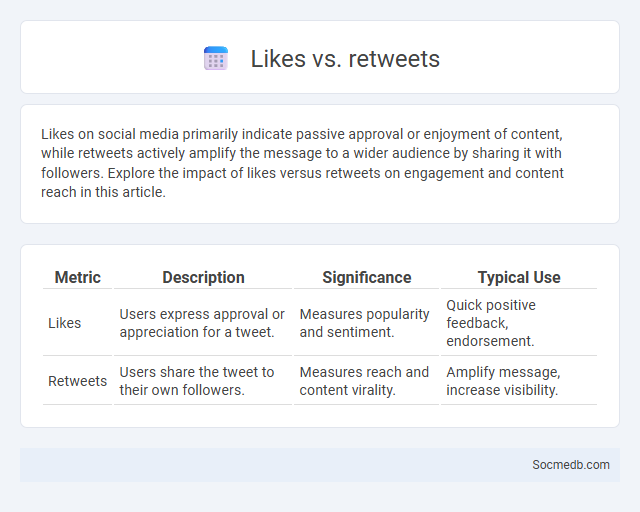
Photo illustration: Likes vs retweets
Likes on social media primarily indicate passive approval or enjoyment of content, while retweets actively amplify the message to a wider audience by sharing it with followers. Explore the impact of likes versus retweets on engagement and content reach in this article.
Table of Comparison
| Metric | Description | Significance | Typical Use |
|---|---|---|---|
| Likes | Users express approval or appreciation for a tweet. | Measures popularity and sentiment. | Quick positive feedback, endorsement. |
| Retweets | Users share the tweet to their own followers. | Measures reach and content virality. | Amplify message, increase visibility. |
Understanding Likes, Retweets, and Reports
Likes, retweets, and reports are key metrics that drive engagement and visibility on social media platforms like Twitter and Instagram. Your interactions with these features influence content popularity and algorithmic reach, where likes signal appreciation, retweets amplify messages to broader audiences, and reports highlight inappropriate or harmful content to moderators. Understanding how each function affects content distribution and community standards helps you navigate and optimize your social media presence effectively.
The Purpose Behind Social Media Likes
Social media likes serve as a quantifiable indicator of user engagement and content popularity, influencing algorithms that determine visibility and reach. They provide instant social proof, validating creators' efforts and fostering community interaction by encouraging further participation. Businesses leverage likes to gauge audience preferences and tailor marketing strategies, enhancing brand awareness and customer loyalty.
How Retweets Amplify Content
Retweets significantly boost content visibility by redistributing posts to a wider audience beyond original followers, enhancing reach and engagement. Each retweet acts as a digital endorsement, increasing credibility and encouraging further interactions such as likes and comments. High retweet frequency directly correlates with viral potential, driving organic growth and strengthening social media presence.
The Role of Reports in Online Safety
Reports play a critical role in maintaining online safety by enabling users to flag harmful content, abusive behavior, and policy violations promptly. Social media platforms utilize these reports to review and remove inappropriate material, protecting the community from cyberbullying, harassment, and misinformation. By actively participating in reporting, you help create a safer digital environment and uphold platform standards for everyone.
Engagement Metrics: Likes vs Retweets
Engagement metrics on social media platforms vary significantly between likes and retweets, with likes indicating user appreciation and passive endorsement, while retweets facilitate content amplification and broader visibility. Retweets often drive higher organic reach and engagement rates as they share content within the retweeter's network, crucial for viral marketing strategies. Data shows posts with higher retweets tend to achieve increased follower growth and deeper audience interaction compared to those receiving mainly likes.
User Intent: Expressing Approval vs Spreading Content
Users expressing approval on social media often engage by liking, favoriting, or reacting to content, signaling personal endorsement without necessarily amplifying the message. In contrast, users focused on spreading content prioritize sharing, retweeting, or reposting to increase visibility and reach, actively contributing to content dissemination. Understanding these distinct user intents is crucial for optimizing engagement strategies and tailoring content to audience behavior patterns.
Reports: Identifying and Flagging Harmful Posts
Advanced social media platforms employ AI-powered algorithms to generate detailed reports that identify and flag harmful posts, enabling faster moderation and content removal. These systems analyze text, images, and user interactions to detect hate speech, misinformation, and cyberbullying with high accuracy. Regular updates to the detection models improve the precision of harmful content identification, ensuring safer online communities and compliance with regulatory guidelines.
Impact on Visibility: Algorithmic Differences
Social media platforms use distinct algorithms that prioritize content based on user engagement, relevance, and recency, significantly impacting visibility. Instagram favors highly visual posts with timely interactions, while Twitter's real-time feed highlights trending topics and tweets with rapid user engagement. LinkedIn's algorithm prioritizes professional content and networking activity, affecting how posts are distributed across users' feeds.
Psychological Effects of Likes and Retweets
Likes and retweets on social media platforms trigger dopamine release, reinforcing reward-seeking behavior and increasing user engagement. This validation can enhance self-esteem temporarily but may also lead to anxiety or depression when expected social approval is not received. Understanding these psychological effects is crucial for managing digital well-being and promoting healthier online interactions.
Managing Negative Feedback and Reports
Effectively managing negative feedback and reports on social media requires prompt responses that acknowledge concerns and offer solutions, helping to maintain your brand's reputation. Monitoring platforms for comments and reviews enables you to identify issues early and engage constructively with dissatisfied users. Your proactive approach in addressing negativity fosters trust and turns potential problems into opportunities for improvement.
 socmedb.com
socmedb.com